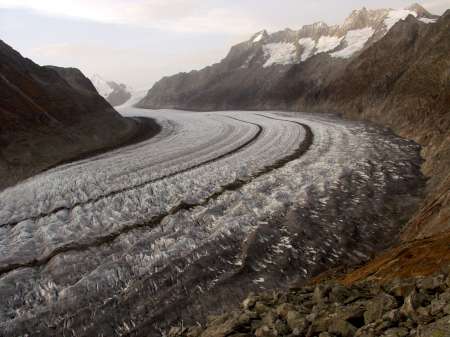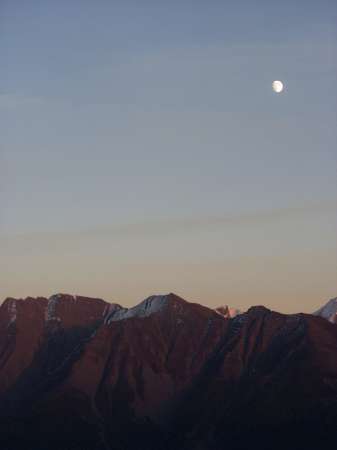Wrap-up from Switzerland
October 20, 2008 – 10:38 am
After a great three-day backpacking trip to the Aletsch Glacier (above), I have returned to Boulder. Now with some perspective, here are some reflections on the scientific issues and questions that we discussed in Switzerland.
During our final day of discussions, we settled on two ideas for potential theory papers. The first idea was to explain the more general advances in modeling that could be achieved by combining process-based models and statistical models. This would be of the most general interest, but would run the risk that readers and reviewers would say, “this is too obvious; people are already doing this.” I don’t think people are exactly doing what we would propose, but it could tough to convince the skeptics. The proof of concept for this approach will have to come later when researchers try to use this approach to develop novel insights and use the techniques on other systems. I would be interested in helping to do this.
The other paper would focus more specifically on mountain ecosystem, explaining how we can better project the effects of the global changes that we are seeing in the mountains. For example, while many groups have attempted to project the results of climate change on various groups of species, few groups have included the effects of nitrogen deposition in predictive models, which could in fact be more important to plant and animal species distributions. Although the audience would be more restricted to the mountain research community, this is probably the safer and more sure paper to write. We will see what comes out!
During our discussions, there were some (potentially) new ideas and unanswered questions that arose. Here are a couple that I wrote down or remembered:
(1) How important are extreme values (season highs and lows, frosts, snowmelt dates etc.) in controlling plant reaction to climate change and how can we incorporate this information into models? Do extreme values change the timing or nature of plant response to climate change?
(2) The location of treeline is a favorite topic for mountain ecologists. Someone at our workshop made the case that people still don’t really agree on what causes treeline to be at a particular level. Part of this may be semantic–what exactly are we asking anyway? For example, a lot of current change in treeline is gap filling below the maximum treeline, instead of actual increase in the highest trees. Does that constitute a “change in treeline?” Breaking apart these concepts and doing some experimental tests on different controlling factors could be interesting. Who knows though, there may be already a ton of research on this. Maybe someone should write an authoritative review. Due to slow tree growth, timescales may be prohibitively long for regular experiments, which could be why there is missing information here. This type of project could work as part of an LTER-type system.
(3) One of the more interesting parts of our discussion for me was talking about a “chicken and egg” issue for the relationship between nitrogen cycling and individual plant species. Obviously plants respond to nutrient levels, but they also indirectly control them through the supply of carbon to the soil microbes. How strong is that control? I believe that we are missing important information on how particular plant species may affect soil nitrogen cycling. For example, what plant characteristics (root exudation, competitive interactions, growth type, etc) determine whether the nitrogen cycling below the plant canopy is high or low? We might survey a whole lot of plant species and determine their various effects on N cycling and try to make some general statements about how they work. There is also the issue of interactions between different types of plants.
Thanks again to our hosts. It was truly a privilege to be able to learn so much and to visit such a beautiful country.

Sorry, comments for this entry are closed at this time.